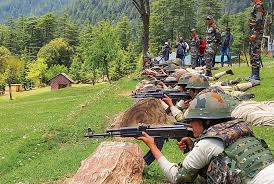India stands at a transformative juncture in global geopolitics—an ascending middle power with aspirations of becoming a leading global actor. And yet, this rise is framed by an unresolved contradiction: while New Delhi articulates a robust foreign and defence policy architecture, it still lacks a publicly articulated National Security Strategy (NSS). In a world marked by rapid technological change, climate disruptions, and emerging geopolitical fault lines, India’s evolving approach to national security demands strategic clarity, coherence, and institutional rigour.
For over seven decades, India has navigated its security challenges through ad hoc frameworks and implicit doctrines. The establishment of the National Security Council (NSC) post-1998, the issuance of the Raksha Mantri’s Operational Directive (RMOD) in 2009, and the creation of the Chief of Defence Staff (CDS) in 2019 are commendable steps. However, they do not substitute for a formal NSS, a document that integrates military preparedness, economic resilience, internal stability, and international diplomacy into a coherent strategic vision.
FROM REACTIVE TO STRATEGIC
At the heart of India’s strategic calculus is its dual challenge: safeguarding sovereignty while fostering national development. These are not mutually exclusive goals. Rather, they must be seen as mutually reinforcing. A weak economy undermines military readiness; porous borders undercut developmental gains. The NSS, therefore, must reflect an integrated approach to national power, balancing conventional and non-traditional threats, from hi-tech to cyber warfare to climate change.
India’s current security environment is shaped by complex threats, ranging from cross-border terrorism and internal insurgencies to energy insecurity and geopolitical realignments. The RMOD addresses several of these concerns. It emphasizes operational preparedness, modernization, interoperability of the tri-services, and cybersecurity. However, the absence of a strategic review or white paper, highlighted by former naval chief Admiral Arun Prakash has led to fragmented policy implementation and stalled reforms like theatre command integration. With media reports indicating that a draft NSS is finally in the works as of 2023, there is both urgency and opportunity to institutionalize India’s strategic ethos.
INDIA IN THE HEGEMONIC CYCLES
India occupies a unique place in the hegemonic cycle as an ascending middle power with aspirations to shape the global order. It plays multiple roles: a “spoiler” of outdated global governance norms, a “supporter” of multilateral institutions, and a “shirker” when expected to shoulder disproportionate burdens. This nuanced positioning is no weakness; rather, it underscores India’s complex identity as both a beneficiary and challenger of the liberal order.
India’s economic ascent with a projected $9 trillion economy by 2030 and ambitions of a $30 trillion GDP by 2047, demands a commensurate strategic posture. The “Amrit Kaal” vision lays out the economic and technological roadmap, but unless matched by security foresight, the gap between aspiration and capability will only widen.
CORE SECURITY DOMAINS
A future NSS must rest on five strategic pillars: safeguarding territorial integrity, ensuring internal stability, securing critical resources, enabling technological sovereignty, and managing external relations while maintaining a robust economic growth trajectory.
India’s border security apparatus has undergone visible transformation with projects like the Atal and Zojila tunnels, and increased deployment of drones and surveillance systems under the Comprehensive Integrated Border Management System (CIBMS). Yet infrastructure gaps and coordination lapses continue to plague India’s preparedness, especially along the Line of Actual Control (LAC) with China. The unfinished business of the LAC, combined with recurring tensions with Pakistan, demands that territorial integrity remain the central tenet of India’s NSS.
India’s defence policy has transitioned from Nehruvian restraint to a more realist, capability-driven framework. Indigenous initiatives under “Make in India,” rising defence exports, and increased private sector involvement as demonstrated during “Operation Sindoor” mark significant progress. India’s nuclear doctrine, based on credible minimum deterrence and No First Use has stood the test of time.
However, rapid technological advancements and adversarial posturing by China and Pakistan call for doctrinal recalibration. The successful hypersonic missile test in 2024 marks a step forward, but critical gaps remain in India’s air defence architecture and the operational range of its submarine-launched ballistic missiles (SLBMs). Equally pressing is the need to strengthen India’s airpower deterrence.
From Kashmir to Manipur, India’s internal security threats are diverse and deeply rooted in cross-border terrorism and socio-political grievances, as has been witnessed in recent events. The reported 70% decline in terrorism-related incidents in Kashmir since 2019 is notable, but Pahalgam like terror attacks by Pakistani proxies demands deeper reforms in policing, smart infrastructure development, and reconciliation.
Cybersecurity, meanwhile, is fast becoming a critical front. India’s rapid digitalization—UPI, Aadhaar, Digital India—has increased vulnerability to cyberattacks. Institutions like India’s Computer Emergency Response Team (CERT) and the National Cyber Security Policy must be strengthened with real-time threat intelligence, international collaboration, and talent acquisition.
RESOURCE SECURITY
India’s dependence on energy imports, over 85% for crude oil and more than 50% for gas poses a strategic vulnerability. Water and food security, too, are under severe stress due to erratic monsoons, groundwater depletion, and population growth. Government initiatives such as the National Solar Mission, ethanol blending, Jal Shakti Abhiyan, and food subsidy reforms under the NFSA reflect policy responsiveness. However, resource security must become a core strategic priority, not merely a developmental goal. Climate-resilient infrastructure, renewable energy capacity, and critical mineral supply chains must feature prominently in the NSS.
FOREIGN POLICY
India’s foreign policy has transitioned from postcolonial idealism to pragmatic realpolitik. Relations with the US have deepened through Quad, 2+2 dialogues, defence manufacturing, and shared Indo-Pacific visions. However, uncertainties caused by Trump’s transactional approaches poses challenges. Meanwhile, the ties with Russia, though resilient, face strains due to global realignments and China-Russia synergy.
China presents the most intricate challenge for India. From economic dependencies to recurring military standoffs, the bilateral relationship is increasingly shaped by deep-rooted strategic mistrust. The Galwan Valley clash in 2020 starkly revealed the fragility of existing confidence-building measures (CBMs) and underscored the risks inherent in asymmetrical power dynamics. The growing China-Pakistan entente, particularly visible during India’s Operation Sindoor in response to the Pahalgam terror attack and its subsequent counterstrike on the terror and military infrastructure deep inside Pakistan has made their coordinated posture against India unmistakably clear.
In contrast, India’s proactive engagement with platforms like BIMSTEC, I2U2, and the Voice of the Global South signals a deliberate move to diversify strategic partnerships and recalibrate regional and global influence. The future NSS must codify the principle of “multi-alignment”, preserving autonomy while leveraging global opportunities. Strategic partnerships must be rooted in mutual benefit, not transactional dependence.
TOWARDS A STRATEGIC CULTURE
India’s most pressing security challenge may stem not merely from hostile intentions of adversaries, but more profoundly from its own institutional inertia as was spelled out by India’s Air Chief Marshal A.P. Singh on May 29, during the CII Summit 2025. A culture of strategic thinking, long-term scenario planning, and inter-ministerial coordination is essential. The NSS must serve as a living document, periodically updated, publicly debated, and anchored in India’s constitutional values and developmental goals. At its core, national security is not just about deterring threats, it’s about shaping an environment in which India’s economic, technological, and human potential can flourish. A coherent NSS is not a luxury; it is a strategic imperative.
* B.R. Deepak is Professor, Center of Chinese and Southeast Asian Studies, Jawaharlal Nehru University, New Delhi.







